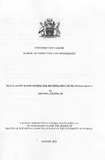| dc.description.abstract | Registration of deaths as a vital event is not effective in Kenya. The master register of dead
persons is not up to date and retrieval of the records is tedious. Many deaths go unreported
despite there being governing regulations and procedures for notification and registration of
deaths occurring in the country and of Kenyan citizens living in other countries. This is attributed
to poor methods and procedures employed in carrying out this process. The problem is
compounded by lack of an effective computerized system for managing the registration process.
Registration of deaths is a mandatory legal requirement in Kenya and in many countries
worldwide. Besides registering to fulfill the legal requirement, a death record has numerous
benefits to individuals, society, businesses and international organizations particularly WHO.
Additionally, civil registration is one of UN recognized human rights. This study aimed to
examine the process of civil registration of deaths and the shortcomings in the current system of
registration of deaths in Kenya. From the shortcomings, bearing in mind the importance and
benefits of registration of a death event, the study sought to provide a technological solution that
isbetter than the current system.
Accuracy and timeliness are the major challenges in civil registration of deaths. The providers
and the users of data are varied and are distributed over wide geographical regions in the country
and abroad. Multiagent system technology was identified as the most appropriate to address
these challenges. Agents are autonomous, proactive and are able to interact with other agents in
the network through agent communication language (ACL). It involved requirement analysis,
design and implementation of the system using the Prometheus MaS methodology. In
requirements analysis stage, system goals were identified as well as percepts and actions.
Architectural design involved determination of agent types and definition of their interactions.
Detailed design involved design of the agent internals. The implementation of the system was
accomplished using various tools including mysql database management system, Java eclipse
IDE and apache- php web server for the web site interface. The implemented system was able to
ensure that all captured data was complete as much as possible. The cause of death and age of
deceased at time of death are vital parameter in determining the usefulness of vital statistics. The
availability of data was assured by way of subscription by interested users. Corrections on
erroneous entries were simplified. A search for existing records was made available in the website. Vital statistics can be computed any time and key fields are available for trend analysis.
They system is scalable; it can be adapted to other vital registrations such as registration of
births, marriages and adoptions. The agents can be distributed in separate hardware to take
advantage of more computing resources. | en |

